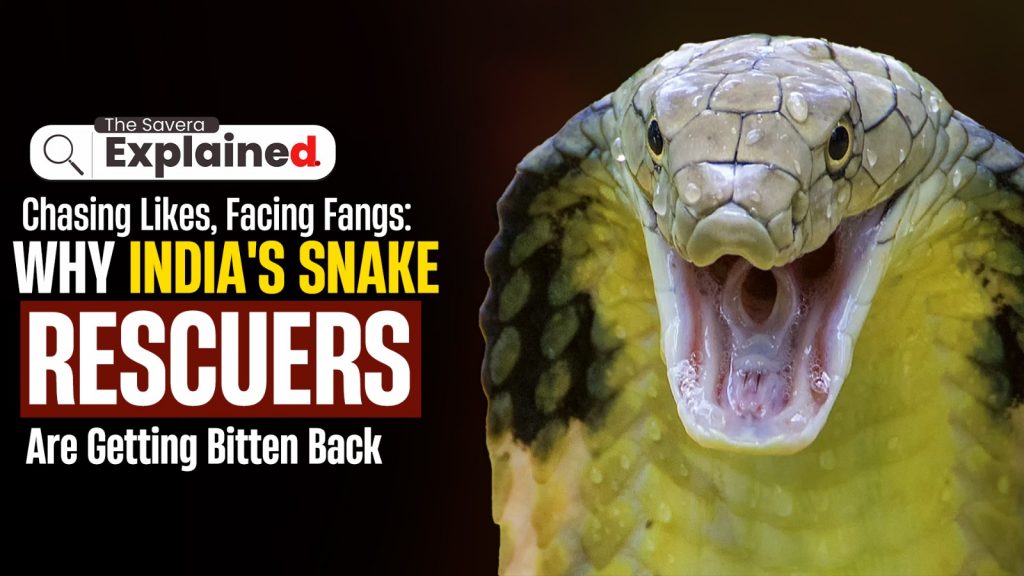India: Snake rescue in India, while often driven by a passion for wildlife conservation, has become a high-risk activity, with many rescuers suffering bites, some fatal.
The rise of social media, lack of regulation, inadequate training, and the dangers of handling venomous snakes have turned this noble pursuit into a deadly gamble for many.
Here’s a closer look at why snake rescuers in India are increasingly at risk.
The Lure of Social Media Fame
The quest for viral fame is a major driver behind risky snake rescues. Social media platforms like YouTube and Instagram have made it easy for rescuers to gain attention by posting dramatic videos of snake handling.
- Viral stunts: Many rescuers perform dangerous acts, like draping venomous snakes around their necks or handling them carelessly, to create eye-catching content.
- Recent cases: In July 2025, a rescuer from Madhya Pradesh died after being bitten by a cobra he was posing with for a video. Similar incidents have occurred in Bihar and Tamil Nadu, where rescuers chasing online fame lost their lives.
These stunts often prioritize views over safety, putting both the rescuer and the snake at risk. The pressure to stand out in a crowded online space pushes many to take reckless chances.
Lack of Regulation
Snake rescue in India operates in a regulatory gray area, with little oversight to ensure safe practices.
- No formal licensing: Most rescuers are volunteers, not certified professionals, and operate without formal authorization from forest departments.
- Unenforced rules: While some states like Kerala have systems like the SARPA app to track certified rescuers, most regions lack such mechanisms, allowing untrained individuals to take up rescue work.
- Forest department reliance: Overburdened forest officials often depend on these volunteers, despite knowing some engage in risky behavior, due to a lack of trained staff.
Without strict guidelines or enforcement, anyone can claim to be a snake rescuer, increasing the chances of mishaps.
Inadequate Training
Proper training is critical for handling venomous snakes, but many rescuers lack it, leading to dangerous mistakes.
- Limited education: Most rescuers are young, often under 40, with minimal formal training in herpetology or snake behavior.
- Learning on the job: Many learn through trial and error, which can be deadly when dealing with species like cobras or kraits, known for their potent venom.
- High-risk handling: Improper techniques, like grabbing snakes by the tail or teasing them for videos, agitate the animals, making bites more likely.
Training programs are scarce, and those available often focus on theory rather than practical skills, leaving rescuers unprepared for real-world challenges.
Dangers of Venomous Snakes
India is home to some of the world’s most venomous snakes, including the “Big Four” — Indian cobra, common krait, Russell’s viper, and saw-scaled viper — which are responsible for most snakebite deaths.
- High venom yield: An agitated snake can inject a large amount of venom, making bites during rescues particularly dangerous.
- Unpredictable behavior: Even docile snakes like kraits can strike unexpectedly, especially when stressed during a rescue.
- Ineffective antivenom: Current polyvalent antivenoms may not fully neutralize venom from non-Big Four species, complicating treatment for bitten rescuers.
The combination of these factors makes snake rescue a high-stakes job, where even a small mistake can be fatal.
The Way Forward
Addressing this alarming trend requires a multi-pronged approach:
- Stricter regulations: Implementing licensing and mandatory training for rescuers can ensure only qualified individuals handle snakes.
- Public awareness: Educating communities about safe snake handling and the risks of viral stunts can reduce reckless behavior.
- Better training programs: Practical, hands-on training focused on safe handling and first aid can equip rescuers to manage risks effectively.
- Penalties for stunts: Fining or banning the posting of risky rescue videos could discourage dangerous antics.
Snake rescue is a vital service in a country where 40-50,000 people die annually from snakebites. However, without addressing the pursuit of fame, lax regulations, poor training, and the inherent dangers of venomous snakes, rescuers will continue to pay a heavy price for their passion.
